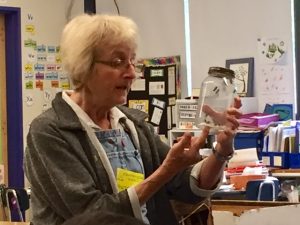 Yesterday, May 11th, the second graders were treated to a taste of fresh honey during a visit from local beekeeper Birgit De Weerd, who showed the children a honeycomb, live bees, and photos of honeybees working in their colonies.
Yesterday, May 11th, the second graders were treated to a taste of fresh honey during a visit from local beekeeper Birgit De Weerd, who showed the children a honeycomb, live bees, and photos of honeybees working in their colonies.
Ms. De Weerd first taught us the many differences between wasps and bees. Bees are a brownish-goldish color. Wasps tend to be yellow and black. People will often say they were stung by a bee when they were stung by a yellow jacket wasp. Bees only sting us if they get scared. Bees die after stinging a person because they cannot live without the stinger, which gets left behind in our skin. If we get stung and there is no stinger in our skin, we know we were not stung by a honeybee. We also learned that honeybees do not come to our cookouts or picnics to eat. Only wasps eat our picnic food. Honeybees eat only pollen and nectar, not hot dogs.
We also learned that bees live in large colonies and each bee has a different job, such as a cleaner, worker, builder, guard or nurse. The largest bee in a colony is called the Queen, who lays about 2000 eggs each day and eats only royal jelly. Ms. De Weerd demonstrated how bees make honey and encouraged the students to observe bees outside during the spring and summer gathering pollen and nectar.
We learned that dandelions are the most important source of nectar for honey bees, so we should try to keep some in our lawns. We also learned that some fertilizers and weed killers kill bees. We learned that if we see a large hive or swarm of bees to just leave them alone. They are looking for a new hive or hollow tree and will move along soon. Or we can call our city and they will send a beekeeper like Ms. De Weerd to come and take them. We should never harm the bees. Honeybees are very important in our food chain because they pollinate all of the fruits and vegetables that we eat. Without honeybees, we would have no food. The world needs honeybees!
Ask your children:
Q: What should we do if we get a bee-sting?
A: Always scratch out the sting. Do not pull or push the spot because any pressure can squeeze more venom into the skin. Put a paper towel with vinegar on the sting.
Q: What is a major predator of bees?
A: Skunks. They scratch the side of the hive, and when the guard bees come to the opening to check the noise, the skunk scoops them up and eats them; repeating the scratch-scoop-eat process all night long. A skunk can eat hundreds of bees in one night because it does not mind getting stung.
Q: What is a drone?
A: A male bee who mates with the Queen. It has no stinger. cannot gather food, and does not do any of the worker jobs in the colony.
Q: How does a beekeeper know winter is coming?
A: All of the drones will be found dead outside the hive. Drones are killed by the other bees in the fall because the colony wants only worker bees to help the hive survive the winter.
